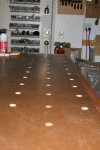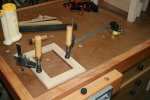Ken Cook
Member
- Messages
- 3,798
Thoughts?
I'm concerned about the holes getting sloppy over time . I'm going with 2 layers of 3/4" along with one of 1/2", topped with an 1/8th or 1/4 ' hardboard. Is this a legitimate concern? Has the sleeve/bushing idea ever been addressed? Or if adding an interior layer of ply would be of benefit? I already have the mdf, so changing over to solid wood is out for now.
. I'm going with 2 layers of 3/4" along with one of 1/2", topped with an 1/8th or 1/4 ' hardboard. Is this a legitimate concern? Has the sleeve/bushing idea ever been addressed? Or if adding an interior layer of ply would be of benefit? I already have the mdf, so changing over to solid wood is out for now.
Just wanting to insure I can get all the reasonably expected life out of them...Thanks in advance
I'm concerned about the holes getting sloppy over time
 . I'm going with 2 layers of 3/4" along with one of 1/2", topped with an 1/8th or 1/4 ' hardboard. Is this a legitimate concern? Has the sleeve/bushing idea ever been addressed? Or if adding an interior layer of ply would be of benefit? I already have the mdf, so changing over to solid wood is out for now.
. I'm going with 2 layers of 3/4" along with one of 1/2", topped with an 1/8th or 1/4 ' hardboard. Is this a legitimate concern? Has the sleeve/bushing idea ever been addressed? Or if adding an interior layer of ply would be of benefit? I already have the mdf, so changing over to solid wood is out for now.Just wanting to insure I can get all the reasonably expected life out of them...Thanks in advance





